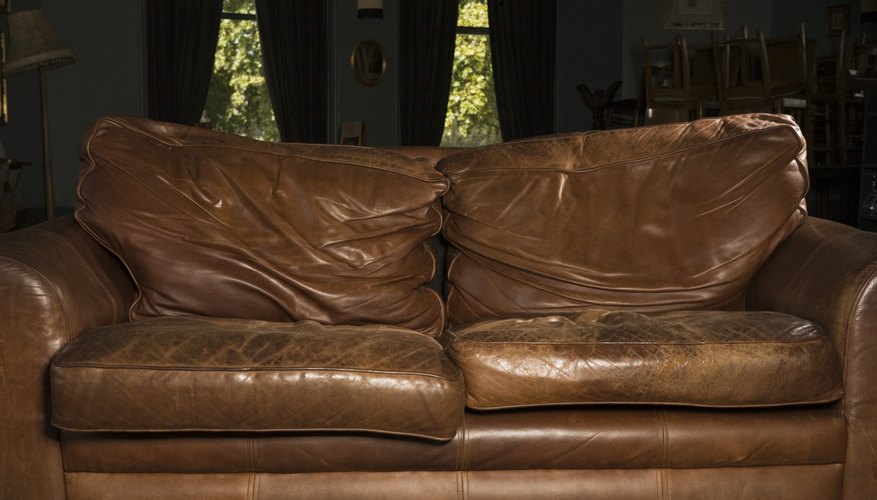According to professional upholsterers Linda Flannery and Jane McDonald, prior to reupholstering an item of furniture, you should remove the existing upholstery so you can examine the frame. The frame might be warped, cracked or even splintered. However, where the sofa cushions are sewn onto the frame, inspection is difficult or impossible.
- According to professional upholsterers Linda Flannery and Jane McDonald, prior to reupholstering an item of furniture, you should remove the existing upholstery so you can examine the frame.
- However, where the sofa cushions are sewn onto the frame, inspection is difficult or impossible.
Find the zip on the sofa cushions. Chair and sofa cushions generally have a zip. Cushions without a zip will have a seam. Unzip the cushion or unpick the seam with a seam ripper.
Reach inside the cushion to remove all of the existing filling, which may be in a sewn or tied bag. According to upholsterer Malcolm Hopkins, the filling will be one of two types -- loose or layered. Loose fillings include coir fibre, hair and feathers. Layered fillings, which come in sheets or rolls, include natural and synthetic materials.
- Reach inside the cushion to remove all of the existing filling, which may be in a sewn or tied bag.
Choose a loose filling to refill sofa cushions sewn onto the frame as layered fillings are likely to be too rigid to manoeuvre into place without damaging them. Choose a new filling material depending on your taste and available budget for the job. Identify the type of filling used and buy more of the same, if you wish to maintain the sofa’s original character. Measure the length, breadth and width of the cushions and ask your filling supplier how much filling you will need.
Pack your chosen filling deep into every corner, especially with irregular-shaped cushions. You need to pack enough filling to bring back the shape of the cushions. With a non-elastic material like leather, the seams generally retain their structural integrity. Pack filling into the corners furthest from the zip or seam until they are plumped up to an even thickness, advise pillow makers Linda Neubauer and Joanne Wawra for a similar project. Use this as a depth guide for the rest of the space in the cushion.
Check how the cushions are looking every now and then to make sure you are not creating bumps and hollows. Pat down any bumps and add handfuls of extra filling to any hollows. Aim to ensure a firm, even, slightly raised but level finish to the cushion top, so sitting on it is comfortable. A sofa cushion should offer support to the spine without being too rigid, giving slightly when someone sits on it.
- Pack your chosen filling deep into every corner, especially with irregular-shaped cushions.
- A sofa cushion should offer support to the spine without being too rigid, giving slightly when someone sits on it.
Close the zip or sew up the seams using a wedge-point needle when you have completed the filling. Proceed in like manner for all the cushions on the sofa. Sit and enjoy the sofa when the job is done.
TIP
A zip or seam pointing downwards presents a particularly difficult problem when it comes to refilling sofa cushions, as gravity will tend to work against you. In a case like this, turn the sofa upside down to give you better access and make the job easier.
Empty, wash and reuse the original bag if you find a bag of filling inside the cushions, where the bag has retained its integrity. Fill the bag almost to capacity before inserting it back into the cushion. Pat it down and plump it up as required before adding more filling to the bag in situ to fill it completely. Tie or sew up the bag as required.
Never mix old filling with new as this can cause sags and depressions.
WARNING
Choose a non-flammable or flame retardant filling material.
